Literature Search Protocol: Hand Hygiene in Nursing Practice
VerifiedAdded on 2022/09/14
|6
|1128
|13
Report
AI Summary
This report outlines a literature search protocol focused on hand hygiene in nursing practice, emphasizing the application of Evidence-Based Practice (EBP). It justifies the need for EBP in healthcare, highlighting its role in improving patient outcomes, reducing costs, and developing superior nursing skills. The report details the use of the PICO process (Problem, Intervention, Comparison, Outcome) to frame an answerable question related to hospital-acquired infections and hand hygiene. The search strategy protocol involves identifying keywords, concepts, and synonyms to effectively search databases. The report includes search results and references, demonstrating the practical application of the literature search protocol. The importance of hand hygiene in preventing infections is emphasized throughout the document, reflecting the need for nurses to have a strong understanding of primary care principles.
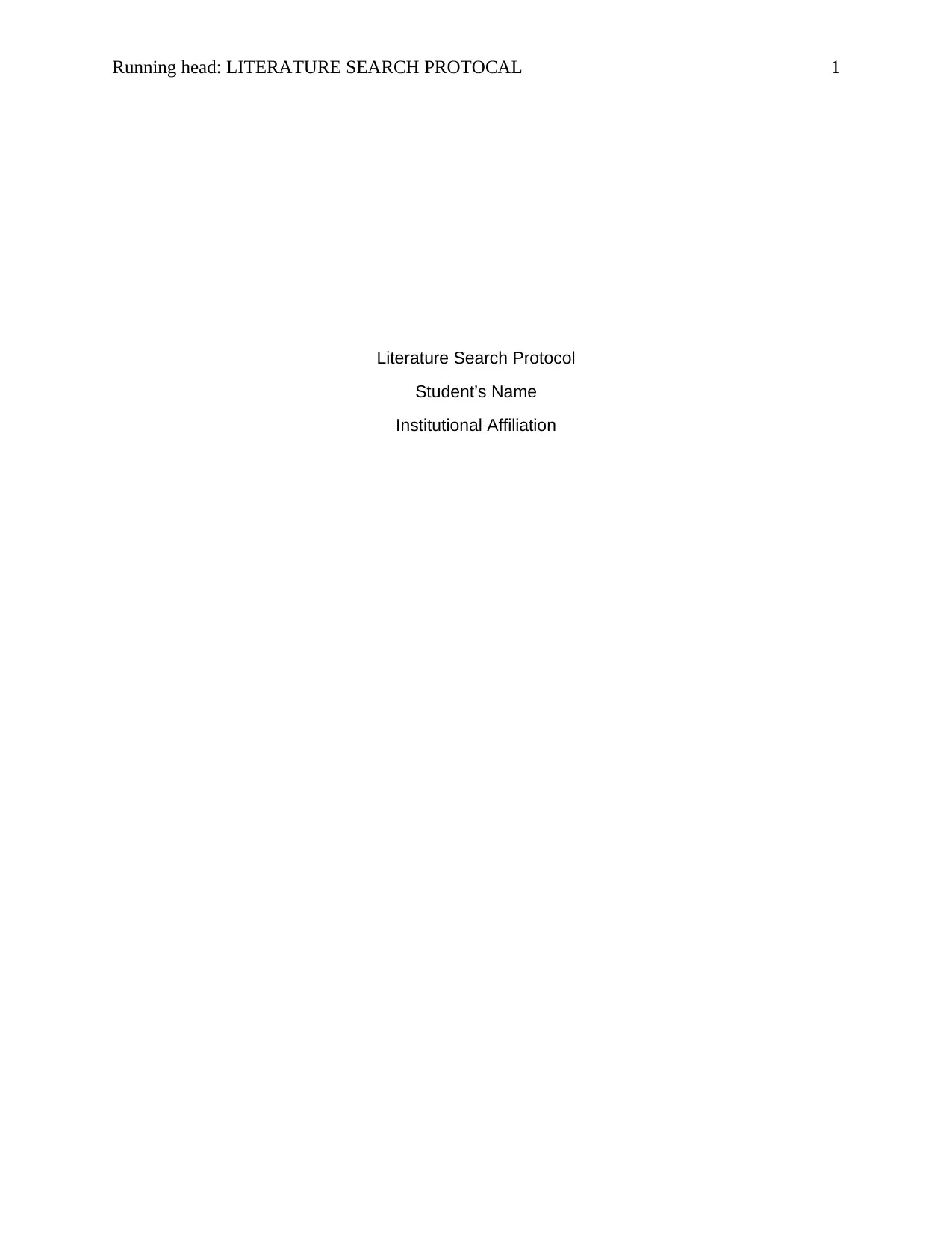
Running head: LITERATURE SEARCH PROTOCAL 1
Literature Search Protocol
Student’s Name
Institutional Affiliation
Literature Search Protocol
Student’s Name
Institutional Affiliation
Paraphrase This Document
Need a fresh take? Get an instant paraphrase of this document with our AI Paraphraser
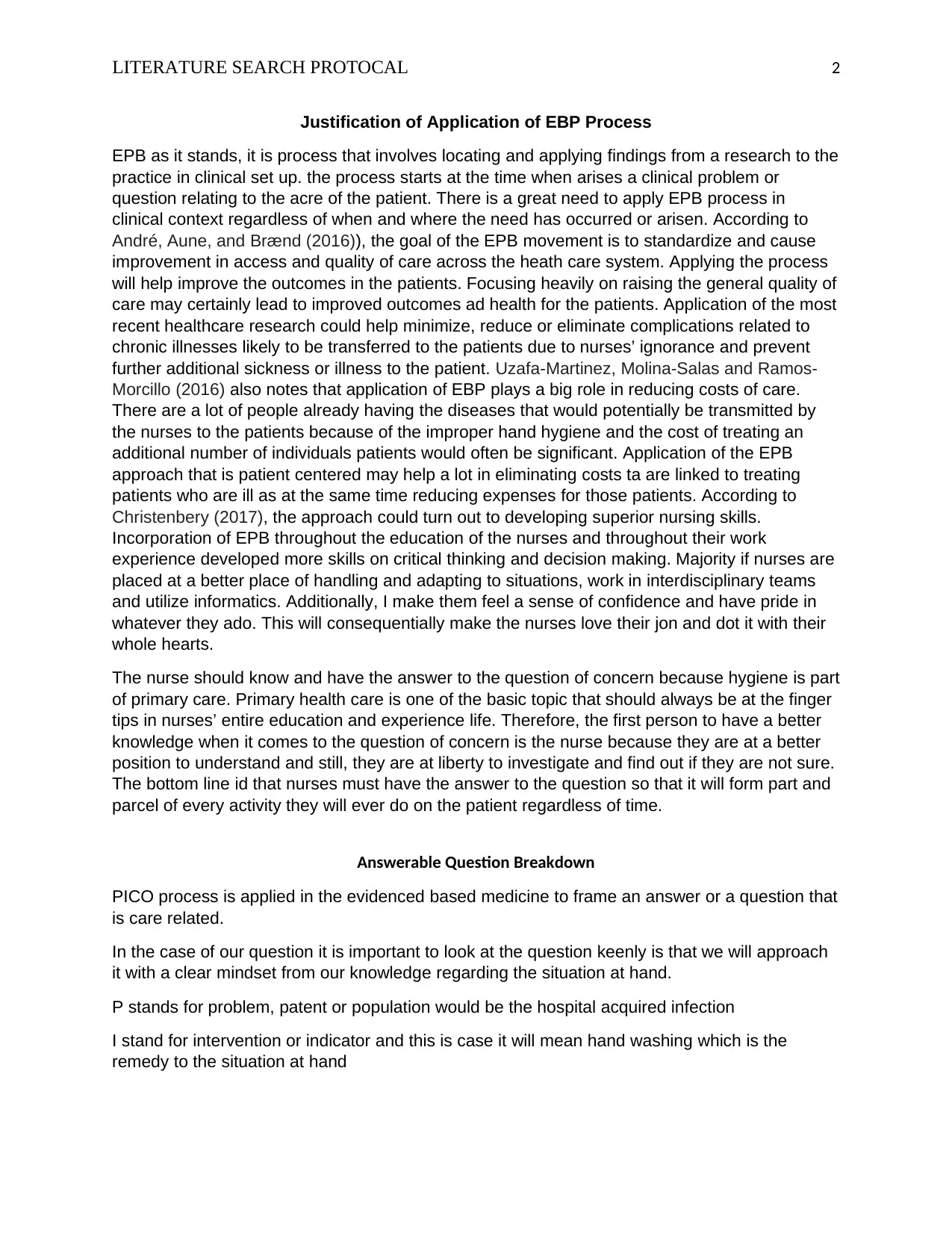
LITERATURE SEARCH PROTOCAL 2
Justification of Application of EBP Process
EPB as it stands, it is process that involves locating and applying findings from a research to the
practice in clinical set up. the process starts at the time when arises a clinical problem or
question relating to the acre of the patient. There is a great need to apply EPB process in
clinical context regardless of when and where the need has occurred or arisen. According to
André, Aune, and Brænd (2016)), the goal of the EPB movement is to standardize and cause
improvement in access and quality of care across the heath care system. Applying the process
will help improve the outcomes in the patients. Focusing heavily on raising the general quality of
care may certainly lead to improved outcomes ad health for the patients. Application of the most
recent healthcare research could help minimize, reduce or eliminate complications related to
chronic illnesses likely to be transferred to the patients due to nurses’ ignorance and prevent
further additional sickness or illness to the patient. Uzafa-Martinez, Molina-Salas and Ramos-
Morcillo (2016) also notes that application of EBP plays a big role in reducing costs of care.
There are a lot of people already having the diseases that would potentially be transmitted by
the nurses to the patients because of the improper hand hygiene and the cost of treating an
additional number of individuals patients would often be significant. Application of the EPB
approach that is patient centered may help a lot in eliminating costs ta are linked to treating
patients who are ill as at the same time reducing expenses for those patients. According to
Christenbery (2017), the approach could turn out to developing superior nursing skills.
Incorporation of EPB throughout the education of the nurses and throughout their work
experience developed more skills on critical thinking and decision making. Majority if nurses are
placed at a better place of handling and adapting to situations, work in interdisciplinary teams
and utilize informatics. Additionally, I make them feel a sense of confidence and have pride in
whatever they ado. This will consequentially make the nurses love their jon and dot it with their
whole hearts.
The nurse should know and have the answer to the question of concern because hygiene is part
of primary care. Primary health care is one of the basic topic that should always be at the finger
tips in nurses’ entire education and experience life. Therefore, the first person to have a better
knowledge when it comes to the question of concern is the nurse because they are at a better
position to understand and still, they are at liberty to investigate and find out if they are not sure.
The bottom line id that nurses must have the answer to the question so that it will form part and
parcel of every activity they will ever do on the patient regardless of time.
Answerable Question Breakdown
PICO process is applied in the evidenced based medicine to frame an answer or a question that
is care related.
In the case of our question it is important to look at the question keenly is that we will approach
it with a clear mindset from our knowledge regarding the situation at hand.
P stands for problem, patent or population would be the hospital acquired infection
I stand for intervention or indicator and this is case it will mean hand washing which is the
remedy to the situation at hand
Justification of Application of EBP Process
EPB as it stands, it is process that involves locating and applying findings from a research to the
practice in clinical set up. the process starts at the time when arises a clinical problem or
question relating to the acre of the patient. There is a great need to apply EPB process in
clinical context regardless of when and where the need has occurred or arisen. According to
André, Aune, and Brænd (2016)), the goal of the EPB movement is to standardize and cause
improvement in access and quality of care across the heath care system. Applying the process
will help improve the outcomes in the patients. Focusing heavily on raising the general quality of
care may certainly lead to improved outcomes ad health for the patients. Application of the most
recent healthcare research could help minimize, reduce or eliminate complications related to
chronic illnesses likely to be transferred to the patients due to nurses’ ignorance and prevent
further additional sickness or illness to the patient. Uzafa-Martinez, Molina-Salas and Ramos-
Morcillo (2016) also notes that application of EBP plays a big role in reducing costs of care.
There are a lot of people already having the diseases that would potentially be transmitted by
the nurses to the patients because of the improper hand hygiene and the cost of treating an
additional number of individuals patients would often be significant. Application of the EPB
approach that is patient centered may help a lot in eliminating costs ta are linked to treating
patients who are ill as at the same time reducing expenses for those patients. According to
Christenbery (2017), the approach could turn out to developing superior nursing skills.
Incorporation of EPB throughout the education of the nurses and throughout their work
experience developed more skills on critical thinking and decision making. Majority if nurses are
placed at a better place of handling and adapting to situations, work in interdisciplinary teams
and utilize informatics. Additionally, I make them feel a sense of confidence and have pride in
whatever they ado. This will consequentially make the nurses love their jon and dot it with their
whole hearts.
The nurse should know and have the answer to the question of concern because hygiene is part
of primary care. Primary health care is one of the basic topic that should always be at the finger
tips in nurses’ entire education and experience life. Therefore, the first person to have a better
knowledge when it comes to the question of concern is the nurse because they are at a better
position to understand and still, they are at liberty to investigate and find out if they are not sure.
The bottom line id that nurses must have the answer to the question so that it will form part and
parcel of every activity they will ever do on the patient regardless of time.
Answerable Question Breakdown
PICO process is applied in the evidenced based medicine to frame an answer or a question that
is care related.
In the case of our question it is important to look at the question keenly is that we will approach
it with a clear mindset from our knowledge regarding the situation at hand.
P stands for problem, patent or population would be the hospital acquired infection
I stand for intervention or indicator and this is case it will mean hand washing which is the
remedy to the situation at hand
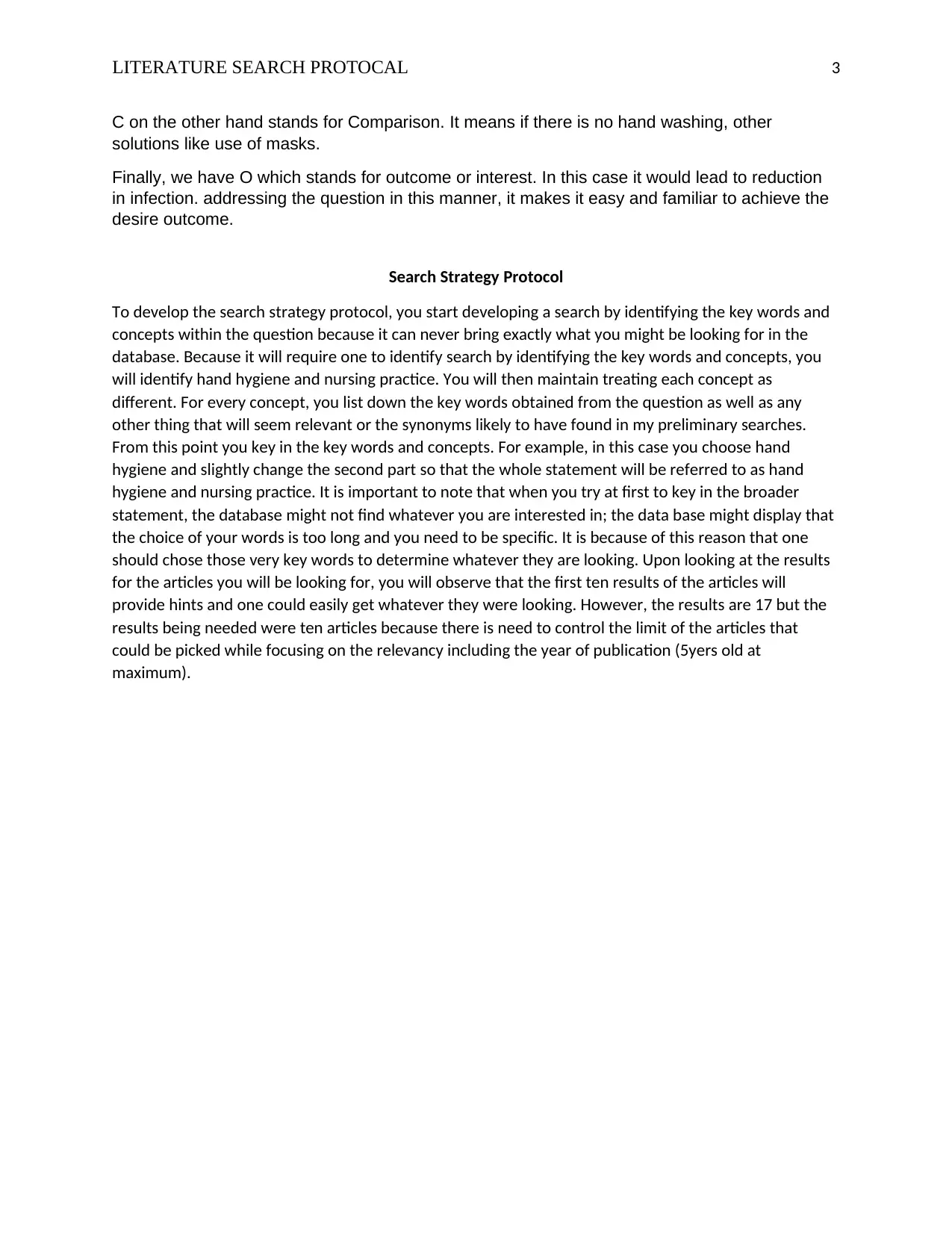
LITERATURE SEARCH PROTOCAL 3
C on the other hand stands for Comparison. It means if there is no hand washing, other
solutions like use of masks.
Finally, we have O which stands for outcome or interest. In this case it would lead to reduction
in infection. addressing the question in this manner, it makes it easy and familiar to achieve the
desire outcome.
Search Strategy Protocol
To develop the search strategy protocol, you start developing a search by identifying the key words and
concepts within the question because it can never bring exactly what you might be looking for in the
database. Because it will require one to identify search by identifying the key words and concepts, you
will identify hand hygiene and nursing practice. You will then maintain treating each concept as
different. For every concept, you list down the key words obtained from the question as well as any
other thing that will seem relevant or the synonyms likely to have found in my preliminary searches.
From this point you key in the key words and concepts. For example, in this case you choose hand
hygiene and slightly change the second part so that the whole statement will be referred to as hand
hygiene and nursing practice. It is important to note that when you try at first to key in the broader
statement, the database might not find whatever you are interested in; the data base might display that
the choice of your words is too long and you need to be specific. It is because of this reason that one
should chose those very key words to determine whatever they are looking. Upon looking at the results
for the articles you will be looking for, you will observe that the first ten results of the articles will
provide hints and one could easily get whatever they were looking. However, the results are 17 but the
results being needed were ten articles because there is need to control the limit of the articles that
could be picked while focusing on the relevancy including the year of publication (5yers old at
maximum).
C on the other hand stands for Comparison. It means if there is no hand washing, other
solutions like use of masks.
Finally, we have O which stands for outcome or interest. In this case it would lead to reduction
in infection. addressing the question in this manner, it makes it easy and familiar to achieve the
desire outcome.
Search Strategy Protocol
To develop the search strategy protocol, you start developing a search by identifying the key words and
concepts within the question because it can never bring exactly what you might be looking for in the
database. Because it will require one to identify search by identifying the key words and concepts, you
will identify hand hygiene and nursing practice. You will then maintain treating each concept as
different. For every concept, you list down the key words obtained from the question as well as any
other thing that will seem relevant or the synonyms likely to have found in my preliminary searches.
From this point you key in the key words and concepts. For example, in this case you choose hand
hygiene and slightly change the second part so that the whole statement will be referred to as hand
hygiene and nursing practice. It is important to note that when you try at first to key in the broader
statement, the database might not find whatever you are interested in; the data base might display that
the choice of your words is too long and you need to be specific. It is because of this reason that one
should chose those very key words to determine whatever they are looking. Upon looking at the results
for the articles you will be looking for, you will observe that the first ten results of the articles will
provide hints and one could easily get whatever they were looking. However, the results are 17 but the
results being needed were ten articles because there is need to control the limit of the articles that
could be picked while focusing on the relevancy including the year of publication (5yers old at
maximum).
⊘ This is a preview!⊘
Do you want full access?
Subscribe today to unlock all pages.

Trusted by 1+ million students worldwide
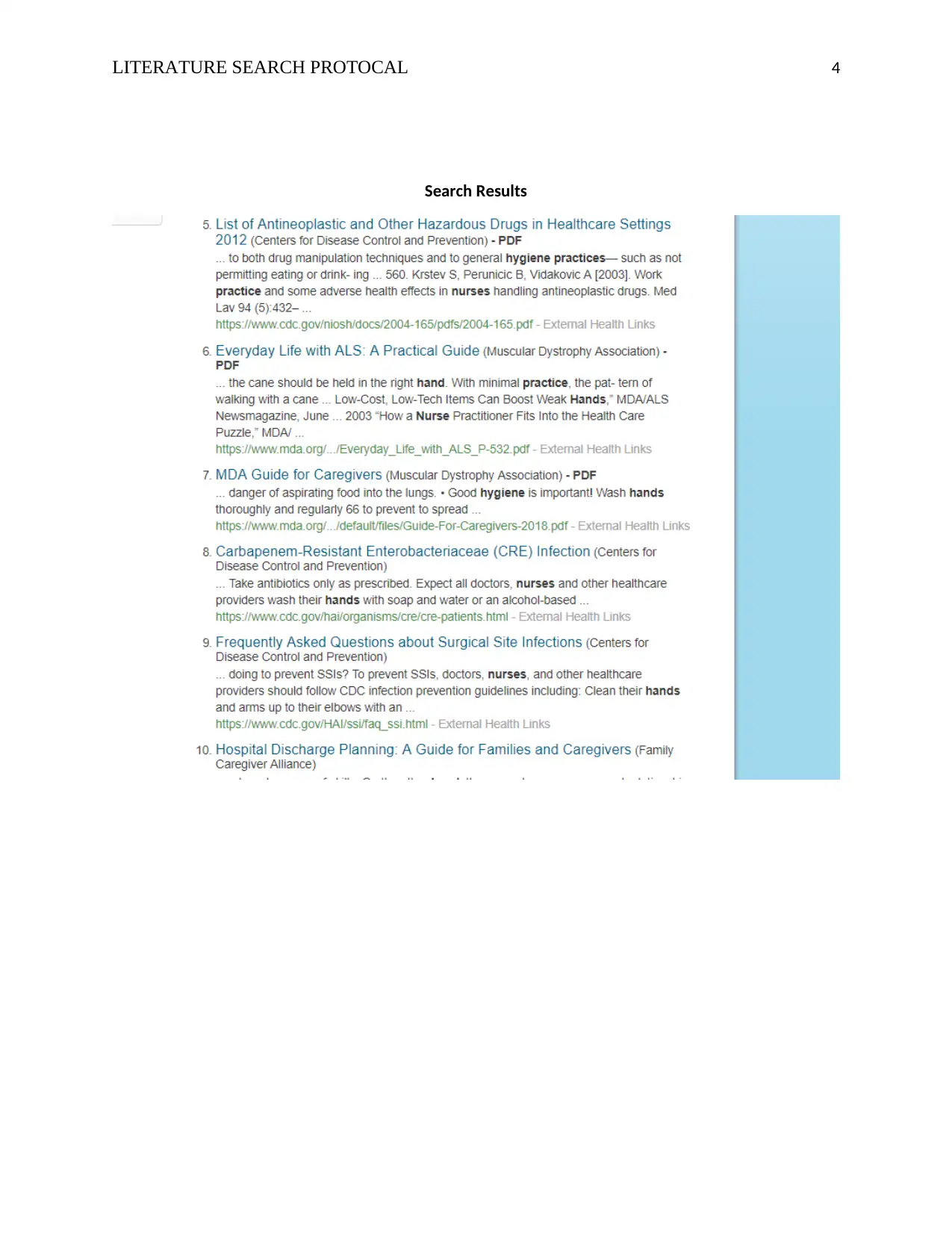
LITERATURE SEARCH PROTOCAL 4
Search Results
Search Results
Paraphrase This Document
Need a fresh take? Get an instant paraphrase of this document with our AI Paraphraser
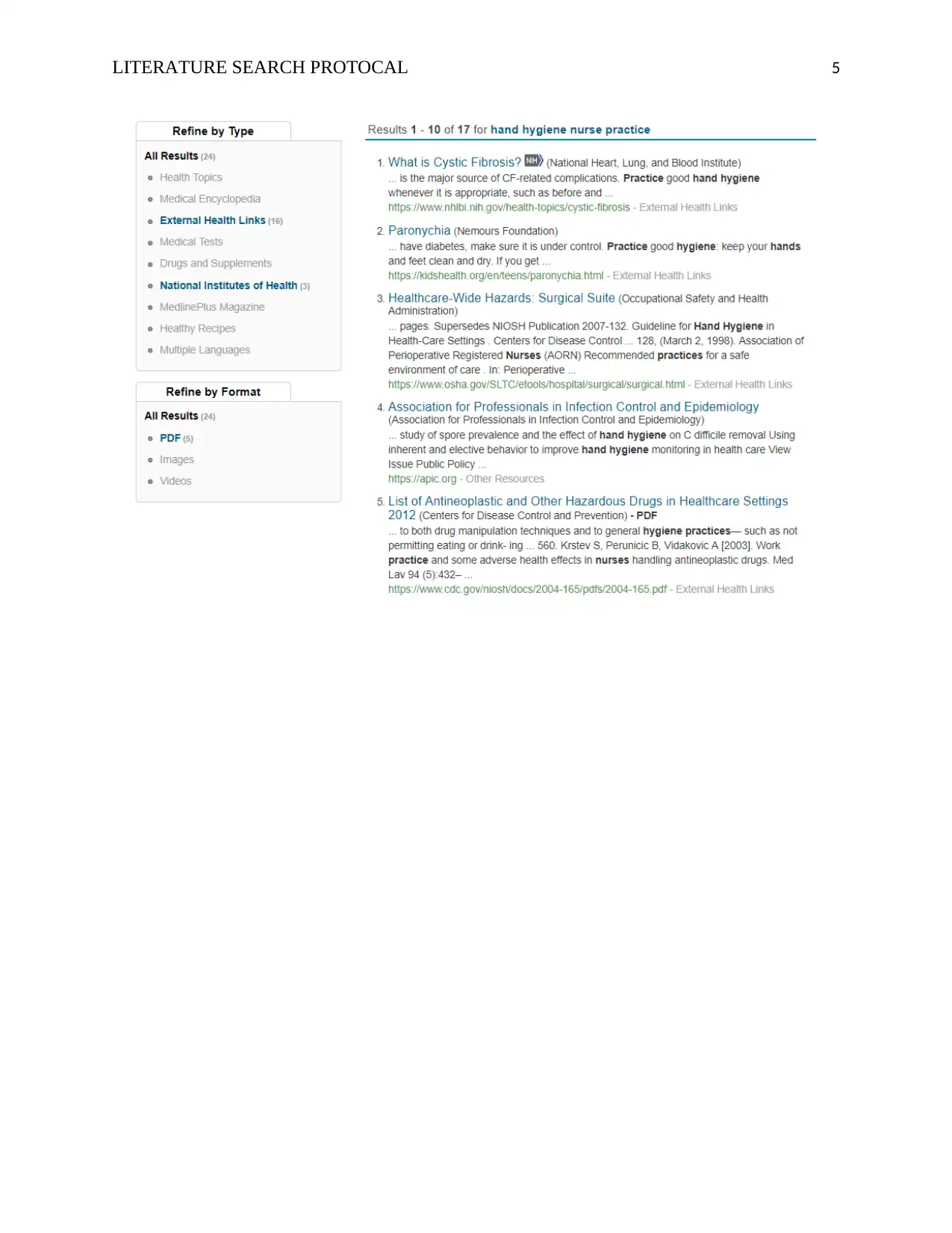
LITERATURE SEARCH PROTOCAL 5

LITERATURE SEARCH PROTOCAL 6
References
André, B., Aune, A. G., & Brænd, J. A. (2016). Embedding evidence-based practice among
nursing undergraduates: results from a pilot study. Nurse education in
practice, 18, 30-35.
Christenbery, T. L. (2017). Nursing Leadership: The Fulcrum of Evidence-Based Practice
Culture. Evidence-Based Practice in Nursing: Foundations, Skills, and Roles.
Ruzafa-Martinez, M., Molina-Salas, Y., & Ramos-Morcillo, A. J. (2016). Evidence-based practice
competence in undergraduate nursing degree students. Enfermeria clinica, 26(3),
158-164.
References
André, B., Aune, A. G., & Brænd, J. A. (2016). Embedding evidence-based practice among
nursing undergraduates: results from a pilot study. Nurse education in
practice, 18, 30-35.
Christenbery, T. L. (2017). Nursing Leadership: The Fulcrum of Evidence-Based Practice
Culture. Evidence-Based Practice in Nursing: Foundations, Skills, and Roles.
Ruzafa-Martinez, M., Molina-Salas, Y., & Ramos-Morcillo, A. J. (2016). Evidence-based practice
competence in undergraduate nursing degree students. Enfermeria clinica, 26(3),
158-164.
⊘ This is a preview!⊘
Do you want full access?
Subscribe today to unlock all pages.

Trusted by 1+ million students worldwide
1 out of 6
Related Documents
Your All-in-One AI-Powered Toolkit for Academic Success.
+13062052269
info@desklib.com
Available 24*7 on WhatsApp / Email
![[object Object]](/_next/static/media/star-bottom.7253800d.svg)
Unlock your academic potential
Copyright © 2020–2025 A2Z Services. All Rights Reserved. Developed and managed by ZUCOL.





